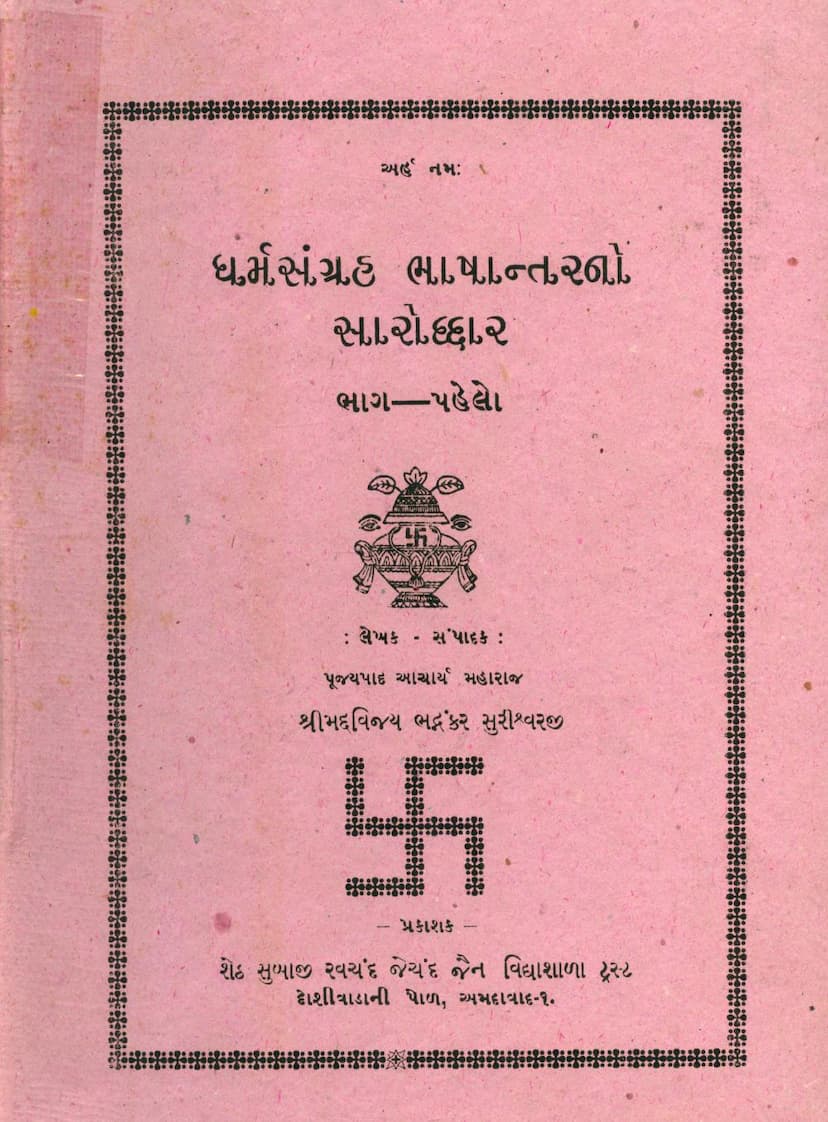Dharm Sangraha Bhashantar Saroddhar Part 01
Added to library: September 1, 2025

Summary
This document is the first part of a Gujarati translation and summary (Saroddhar) of the Jain text "Dharm Sangraha" by Acharya Vijay Bhadrankarsuri. It was published by Seth Subaji Ravchand Jechand Jain Vidyashala Trust in Ahmedabad.
The document provides a detailed introduction and commentary on the book, covering various aspects:
-
Introduction (Udbodhan): Emphasizes the importance of knowledge as a light for societal progress and highlights the significance of Jain scriptures for spiritual liberation. It introduces "Shri Dharm Sangraha" as a crucial part of this knowledge.
-
Author and Creation: It delves into the lineage of the author, Upadhyay Shri Manvijayji Ganivar, tracing his spiritual lineage through various esteemed Acharyas. It also mentions the completion of the original work in Vikram Samvat 1731 (corresponding to the late 17th to early 18th century).
-
Contributors and Inspirations: It acknowledges the valuable contributions of Vachak Shri Yashovijayji Maharaj for his commentary and purification of the text, as well as Vachak Shri Lavanyavijayji for his research. It also credits Seth Shantidas, a descendant of the Anandji Kalyanji Pedhi, and his father Sheth Mayabhai for inspiring the creation of the original text.
-
Content of the Book: The "Dharm Sangraha" is divided into four sections:
- General Dharma for Householders: Covers thirty-five principles of righteous conduct for lay Jains, emphasizing ethical wealth acquisition and general virtuous living.
- Special Dharma for Householders: Discusses more specific religious practices for householders, including faith, right conduct, adherence to vows (like the twelve vows of Shravaks), daily rituals (like Jin-puja, Dev-vandan, Pratikraman), dietary restrictions (Bhakshya-Abhakshya), financial management of religious offerings, and various festivals and observances. The importance of these practices for societal peace and individual well-being is highlighted.
- Sadhu Dharma (Sapeksha Yati): Deals with the conduct of monks and ascetics, described as followers of the Sthavira Kalpa tradition, who observe strict vows within the boundaries of their lineage.
- Sadhu Dharma (Nirapeksha Yati): Focuses on the conduct of ascetics who are completely detached from any lineage or external affiliations, following the Jina Kalpa path and renouncing all worldly attachments, including wealth, possessions, and sensual pleasures, to embrace the Mahavratas (great vows) for ultimate liberation.
-
Key Themes and Concepts:
- Knowledge: The indispensable role of knowledge (Jnana) in overcoming ignorance and achieving liberation.
- Dharma: The core concept of righteousness, encompassing ethical conduct, devotion, self-discipline, and spiritual practices.
- Ahimsa: The fundamental principle of non-violence, extending from physical actions to speech and thought.
- Syadvada: The Jain doctrine of conditional predication, emphasizing the multifaceted nature of truth and the importance of a balanced perspective.
- Karma: The underlying principle of action and reaction, and the path to liberation through spiritual practices.
- Householder's Duty: The book details the duties and ethics for lay followers, emphasizing the importance of righteous living in both material and spiritual aspects.
- Ascetic's Path: It outlines the rigorous path of renunciation and self-mastery for monks aiming for complete liberation.
-
Author's Style and Scope: The text is noted for its comprehensive and insightful presentation of Jain philosophy and practice, drawing from various scriptures and presenting complex concepts with clarity. The author's extensive knowledge in grammar, logic, literature, and philosophy is evident.
-
Guidance on Contemporary Issues: The book is presented as a guide for resolving contemporary debates within the Jain community, such as the use of temple funds ("Devadravya") and the adherence to specific religious observances ("Tithi Aradhana").
-
Other Works of the Author: It mentions other literary contributions of Acharya Bhadrankarsuri as a renowned Gujarati poet of the 18th century.
-
Translation Aspect: The document highlights that this is a translation of the original work, aimed at making the profound knowledge accessible to a wider audience in their vernacular language. The translator's dedication and the value of such translations for preserving and disseminating spiritual wisdom are underscored.
In essence, this document is a laudatory introduction and summary of "Dharm Sangraha Bhashantar Saroddhar Part 01," positioning it as a seminal work in Jain literature, offering guidance on righteous living for both householders and ascetics, and emphasizing the profound spiritual insights of Acharya Vijay Bhadrankarsuri.